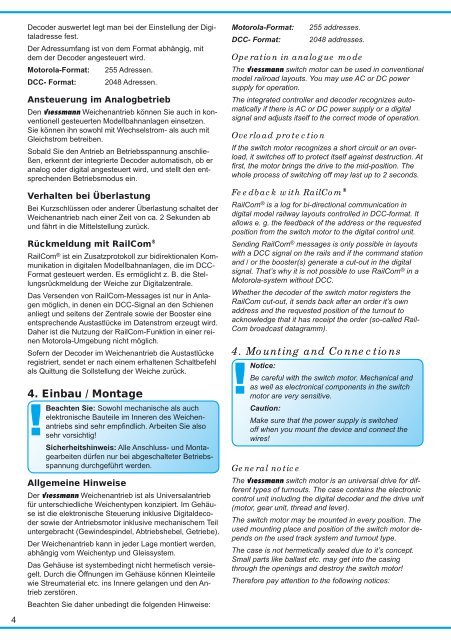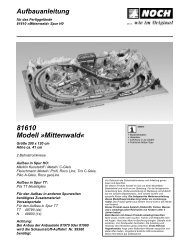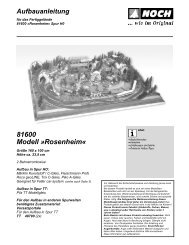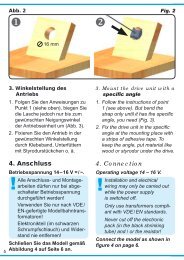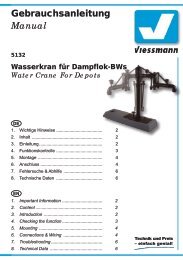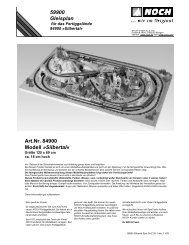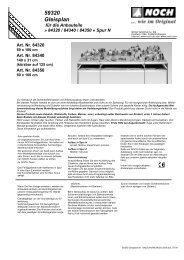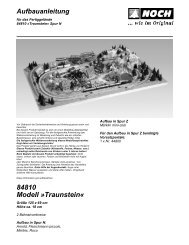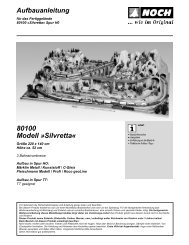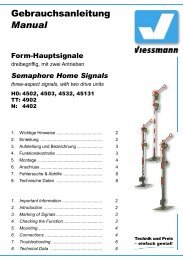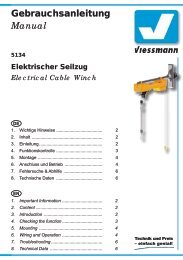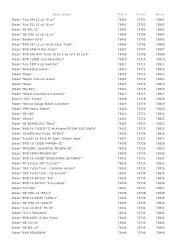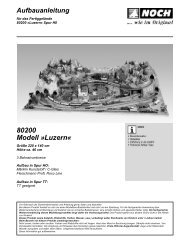Viessmann Anleitung Weichenantrieb 4554 - Reynaulds
Viessmann Anleitung Weichenantrieb 4554 - Reynaulds
Viessmann Anleitung Weichenantrieb 4554 - Reynaulds
Sie wollen auch ein ePaper? Erhöhen Sie die Reichweite Ihrer Titel.
YUMPU macht aus Druck-PDFs automatisch weboptimierte ePaper, die Google liebt.
4<br />
Decoder auswertet legt man bei der Einstellung der Digitaladresse<br />
fest.<br />
Der Adressumfang ist von dem Format abhängig, mit<br />
dem der Decoder angesteuert wird.<br />
Motorola-Format: 255 Adressen.<br />
DCC- Format: 2048 Adressen.<br />
Ansteuerung im Analogbetrieb<br />
Den <strong>Viessmann</strong> <strong>Weichenantrieb</strong> können Sie auch in konventionell<br />
gesteuerten Modellbahnanlagen einsetzen.<br />
Sie können ihn sowohl mit Wechselstrom- als auch mit<br />
Gleichstrom betreiben.<br />
Sobald Sie den Antrieb an Betriebsspannung anschließen,<br />
erkennt der integrierte Decoder automatisch, ob er<br />
analog oder digital angesteuert wird, und stellt den entsprechenden<br />
Betriebsmodus ein.<br />
Verhalten bei Überlastung<br />
Bei Kurzschlüssen oder anderer Überlastung schaltet der<br />
<strong>Weichenantrieb</strong> nach einer Zeit von ca. 2 Sekunden ab<br />
und fährt in die Mittelstellung zurück.<br />
Rückmeldung mit RailCom ®<br />
RailCom ® ist ein Zusatzprotokoll zur bidirektionalen Kommunikation<br />
in digitalen Modellbahnanlagen, die im DCC-<br />
Format gesteuert werden. Es ermöglicht z. B. die Stellungsrückmeldung<br />
der Weiche zur Digitalzentrale.<br />
Das Versenden von RailCom-Messages ist nur in Anlagen<br />
möglich, in denen ein DCC-Signal an den Schienen<br />
anliegt und seitens der Zentrale sowie der Booster eine<br />
entsprechende Austastlücke im Datenstrom erzeugt wird.<br />
Daher ist die Nutzung der RailCom-Funktion in einer reinen<br />
Motorola-Umgebung nicht möglich.<br />
Sofern der Decoder im <strong>Weichenantrieb</strong> die Austastlücke<br />
registriert, sendet er nach einem erhaltenen Schaltbefehl<br />
als Quittung die Sollstellung der Weiche zurück.<br />
4. Einbau / Montage<br />
Beachten Sie: Sowohl mechanische als auch<br />
elektronische Bauteile im Inneren des <strong>Weichenantrieb</strong>s<br />
sind sehr empfindlich. Arbeiten Sie also<br />
sehr vorsichtig!<br />
Sicherheitshinweis: Alle Anschluss- und Montagearbeiten<br />
dürfen nur bei abgeschalteter Betriebsspannung<br />
durchgeführt werden.<br />
Allgemeine Hinweise<br />
Der <strong>Viessmann</strong> <strong>Weichenantrieb</strong> ist als Universalantrieb<br />
für unterschiedliche Weichentypen konzipiert. Im Gehäuse<br />
ist die elektronische Steuerung inklusive Digitaldecoder<br />
sowie der Antriebsmotor inklusive mechanischem Teil<br />
untergebracht (Gewindespindel, Abtriebshebel, Getriebe).<br />
Der <strong>Weichenantrieb</strong> kann in jeder Lage montiert werden,<br />
abhängig vom Weichentyp und Gleissystem.<br />
Das Gehäuse ist systembedingt nicht hermetisch versiegelt.<br />
Durch die Öffnungen im Gehäuse können Kleinteile<br />
wie Streumaterial etc. ins Innere gelangen und den Antrieb<br />
zerstören.<br />
Beachten Sie daher unbedingt die folgenden Hinweise:<br />
Motorola-Format:<br />
DCC- Format:<br />
255 addresses.<br />
2048 addresses.<br />
Operation in analogue mode<br />
The <strong>Viessmann</strong> switch motor can be used in conventional<br />
model railroad layouts. You may use AC or DC power<br />
supply for operation.<br />
The integrated controller and decoder recognizes automatically<br />
if there is AC or DC power supply or a digital<br />
signal and adjusts itself to the correct mode of operation.<br />
Overload protection<br />
If the switch motor recognizes a short circuit or an overload,<br />
it switches off to protect itself against destruction. At<br />
first, the motor brings the drive to the mid-position. The<br />
whole process of switching off may last up to 2 seconds.<br />
Feedback with RailCom ®<br />
RailCom ® is a log for bi-directional communication in<br />
digital model railway layouts controlled in DCC-format. It<br />
allows e. g. the feedback of the address or the requested<br />
position from the switch motor to the digital control unit.<br />
Sending RailCom ® messages is only possible in layouts<br />
with a DCC signal on the rails and if the command station<br />
and / or the booster(s) generate a cut-out in the digital<br />
signal. That’s why it is not possible to use RailCom ® in a<br />
Motorola-system without DCC.<br />
Whether the decoder of the switch motor registers the<br />
RailCom cut-out, it sends back after an order it’s own<br />
address and the requested position of the turnout to<br />
acknowledge that it has receipt the order (so-called Rail-<br />
Com broadcast datagramm).<br />
4. Mounting and Connections<br />
Notice:<br />
Be careful with the switch motor. Mechanical and<br />
as well as electronical components in the switch<br />
motor are very sensitive.<br />
Caution:<br />
Make sure that the power supply is switched<br />
off when you mount the device and connect the<br />
wires!<br />
General notice<br />
The <strong>Viessmann</strong> switch motor is an universal drive for different<br />
types of turnouts. The case contains the electronic<br />
control unit including the digital decoder and the drive unit<br />
(motor, gear unit, thread and lever).<br />
The switch motor may be mounted in every position. The<br />
used mounting place and position of the switch motor depends<br />
on the used track system and turnout type.<br />
The case is not hermetically sealed due to it’s concept.<br />
Small parts like ballast etc. may get into the casing<br />
through the openings and destroy the switch motor!<br />
Therefore pay attention to the following notices:


